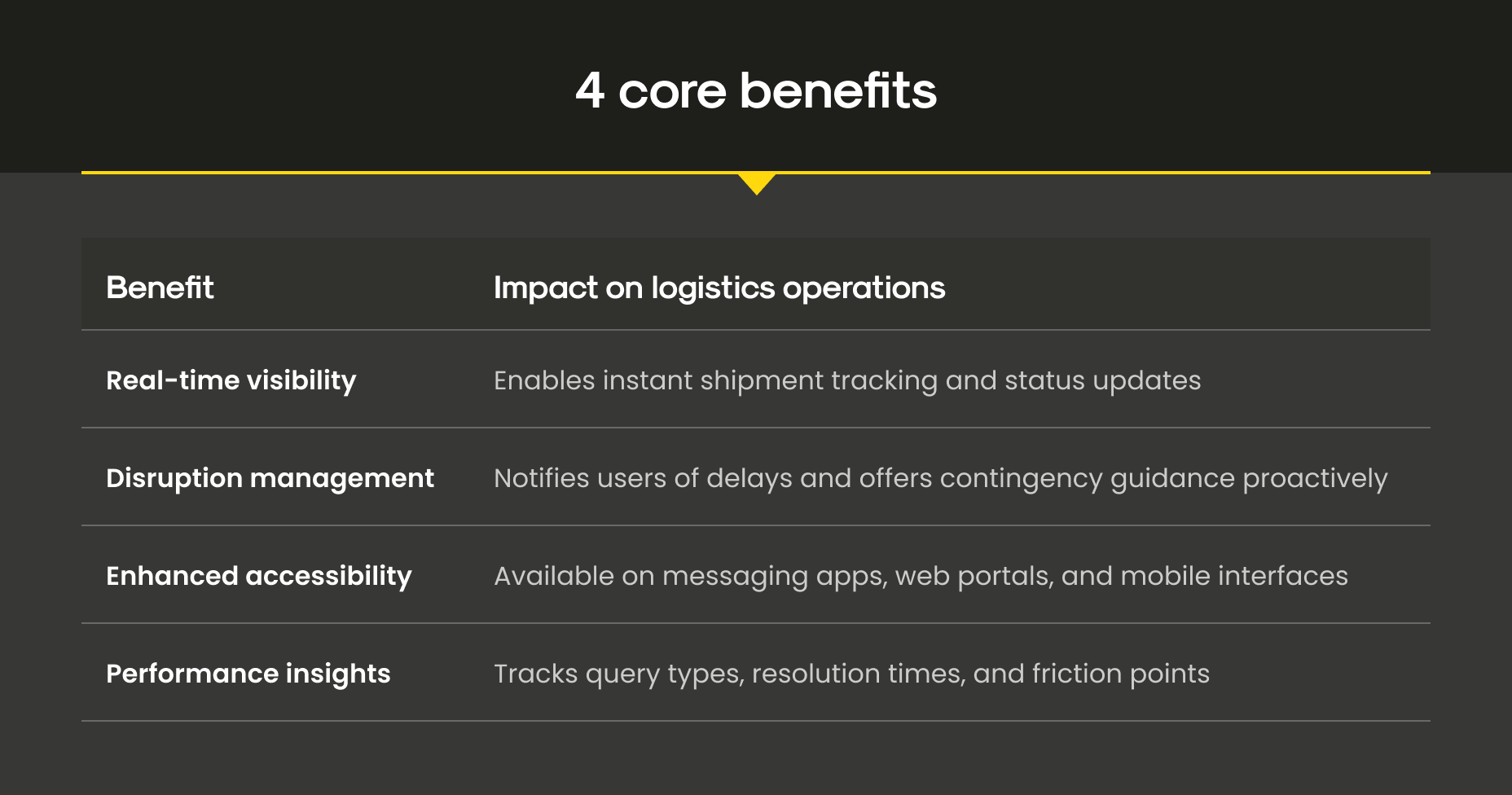In logistics where speed, reliability, and transparency are non-negotiable, customer expectations are notoriously high. Ask industry professionals, and they’ll tell you that clients demand instant updates, seamless interactions, and proactive support at any hour. In this regard, AI chatbots are stepping in as powerful assets, delivering 24/7 availability, operational efficiency, and customer satisfaction.
Unlike traditional support teams that depend on shift schedules, chatbots never clock out. They handle routine queries such as shipment status, delivery windows, and documentation instantly, while escalating complex cases to human agents with all the necessary context. This balance not only speeds up response times but also frees staff to focus on high-value problem-solving, turning customer service from a cost center into a competitive advantage. In this article, you’ll learn:
- Why customer expectations in logistics demand 24/7 service, instant updates, and proactive engagement.
- How AI chatbots handle routine queries, scale during disruptions, and deliver multilingual, cross-border support.
- Real-world case studies from Uber Freight and FourKites, showing how AI transforms raw logistics data into actionable insights.
- The four major benefits of chatbot deployments from real-time visibility to performance analytics.
- Common deployment challenges and how to overcome them, from accuracy issues to customer adoption barriers.
- Best practices for executives to lead chatbot strategies with transparency, scalability, and trust.
- A step-by-step blueprint for rolling out chatbots in logistics, from pilot projects to full-scale integration.
Why AI chatbots matter in logistics
As of today, AI chatbots have become essential tools for managing complex global operations. With delivery networks stretching across time zones and customer expectations climbing higher than ever, logistics providers can’t afford delays, language barriers, or inconsistent service. Chatbots step in as scalable digital assistants, ensuring every customer, whether a small shipper or a multinational client, gets fast and reliable answers around the clock.
1. Around-the-clock availability
Customer queries don’t stop after business hours. Whether it’s nighttime delivery delays or customs questions, chatbots ensure immediate, consistent responses anytime.
2. Scalability during disruptions
During peak periods or crises (like port delays or extreme weather), chatbots handle surges in queries without requiring additional staff, maintaining service levels under pressure.
3. Cost savings and efficiency
Automating routine questions such as “Where’s my shipment?” or “What’s the ETA?” frees up human agents to focus on more complex customer interactions.
4. Multilingual support
Global operations demand multilingual customer care. Chatbots easily scale across languages, creating universal coverage without extensive hiring.
5. Actionable analytics
Every interaction provides data (like common pain points, friction areas, and demand spikes) that logistics teams can analyze and use to continuously refine operations.
Key takeaway
By providing nonstop availability, absorbing surges in demand, and generating valuable operational insights, AI chatbots in logistics allow businesses to meet sky-high client expectations without burning out teams or inflating costs. The result is tangible: faster service, happier customers, and leaner, more resilient logistics operations.
Real-world case study: Uber Freight & FourKites chatbots in action
According to The Wall Street Journal, logistics platforms Uber Freight and FourKites have implemented AI-powered chatbots capable of answering complex, conversational queries (say, like shipment delays or peer performance comparisons) in real time.
- Uber Freight: Their chatbot enables shippers and carriers to ask questions such as “Which routes frequently experience delays?” or “Where am I overspending on transit times?” Instead of manually analyzing historical route performance, users get instant, data-backed answers delivered in natural language. The system is already moving toward a prescriptive mode: offering dynamic recommendations to optimize lane selection, cut down on costly dwell times, and accelerate delivery schedules. This transforms the platform from a passive data hub into an active co-pilot for logistics decision-making.
- FourKites: Their solution goes a step further into disruption management. Clients like Bayer use its chatbot to monitor events such as port congestion, labor strikes, or weather-related delays, for instance, shipping interruptions near the Red Sea. Instead of vague status updates, the chatbot provides granular visibility into container location, the root cause of the disruption, and (most importantly) recommended actions to mitigate risk. For global supply chains, this means teams can shift routes, reallocate inventory, or alert partners before minor issues snowball into major delays.
In a nutshell, these capabilities represent a major leap forward for logistics: replacing manual data lookups and delays with conversational, actionable insights that help teams make proactive, data-informed decisions day or night.
The bottom line
What’s striking about these examples is how AI chatbots are no longer limited to handling surface-level FAQs. They’re digging into the operational core, turning massive, scattered logistics data into clear, immediate answers. Instead of wasting time on dashboards and spreadsheets, teams can simply ask and act. This shift gives logistics professionals sharper visibility and faster control in an industry where every hour counts.
Expanding the value: four benefits in logistics chatbot deployments
Here are four core benefits logistics leaders can derive from AI chatbots:

Benefits of chatbots in logistics
Organizations like parcel carriers and cross-border logistics providers are already using chatbots to improve communication, reduce human workload, and raise transparency for end customers.
Overcoming common cap deployment challenges
1. Maintaining answer accuracy and trust
Incorrect or overly confident responses can erode trust. Clearly communicate bots’ capabilities and provide easy escalation to human agents.
2. Handling complex queries smoothly
Ensure seamless handoff to agents when the bot’s ability ends, preserving context for the human to avoid frustration.
3. System integration is critical
Chatbots must link with real-time tracking systems, TMS, and control towers to serve accurate, up-to-date information.
4. Encouraging customer adoption
Some users resist automation. Reduce friction by offering wait-time estimates, clear disclaimers, and fast access to human support.
Best practices for executives leading logistics operations
While AI chatbots can handle much of the heavy lifting, their value depends on how executives implement and guide them. A poorly deployed chatbot becomes a frustration engine, eroding trust instead of building it. But when leaders treat chatbots not just as automation tools, but as customer-facing team members that complement human agents, the results are dramatic: reduced overhead, faster resolutions, and happier customers.
The key lies in steering chatbot strategy with foresight: designing escalation paths, embedding transparency, and harnessing real-world data for continuous improvement. For executives, this isn’t about adding another piece of tech to the stack; it’s about shaping the customer journey at scale with precision and empathy.
- Design smart escalation paths. Let chatbots handle routine queries but seamlessly pass complex issues to human agents, sharing the full conversation history for context.
- Use data to optimize continuously. Monitor interactions to spot FAQ gaps, refine conversational flows, and retrain AI to align with evolving customer needs.
- Deliver multi-channel coverage. Deploy chatbots across web, mobile apps, WhatsApp, and SMS to meet customers on their preferred platforms.
- Embed transparency and trust. Disclose when users are talking to AI, provide realistic wait times, and clearly signal handoffs to human agents.
- Enhance proactivity. Configure bots to alert customers about delays, customs issues, or rerouting before they even ask.
Is there any secret sauce? Well, leadership makes the difference between a chatbot that truly enhances the customer experience and one that clutters it with robotic dead ends. Executives who align chatbot deployments with business strategy, foster trust through transparent design, and continually refine performance with data insights will see tangible gains in customer loyalty and operational efficiency.
In logistics, where every second counts and reputation is built on reliability, those who lead with smart chatbot practices position their companies not only to meet demand but to stay ahead of it.
Implementation overview: a chatbot rollout blueprint
While the promise of 24/7 service and faster resolutions sounds attractive, the real payoff only comes when implementation is deliberate and structured. Think of it less as a “plug-and-play” tool and more as a phased transformation. Logistics companies that succeed with chatbots tend to start small, prove impact, and then scale, avoiding the chaos of trying to automate everything at once. The blueprint below outlines a pragmatic path forward, from quick wins to deeper integration, ensuring the chatbot not only works technically but also delivers measurable business results.
- Start with low-hanging fruit. Identify high-volume, simple inquiries such as “Where’s my shipment?” as pilot chatbot scenarios.
- Connect to real-time data sources. Integrate with TMS, GPS, and control towers for live updates and reliability.
- Train and validate. Begin with scripted flows, test with real-world data, monitor accuracy, and iterate using actual user paths.
- Enable seamless escalation. Build smooth switches to live agents when queries exceed AI scope to avoid user frustration.
- Track and optimize. Measure resolution times, user satisfaction, fallback rates, and continually adjust intent logic and scripts.
The secret to a successful chatbot rollout is a proper iteration policy. By focusing first on high-volume, repetitive tasks, logistics teams can deliver immediate wins while learning how customers interact with the system. As real-world usage shapes the bot, integrations deepen, and escalation paths smooth out, the chatbot evolves from a support sidekick into a core operational tool. Done right, this blueprint modernizes customer service and creates a scalable digital asset that grows smarter and more valuable with every interaction.
How Mitrix can help
At Mitrix, we deliver AI/ML and generative AI development services that help companies:
- Design intelligent bots that understand supply chain workflows
- Integrate chatbots with tracking systems, CRMs, ERPs, and TMSs
- Build multilingual, multi-channel support agents (WhatsApp, web, SMS)
- Monitor performance and apply machine learning for ongoing improvements
At Mitrix, we build AI agents designed around your needs, whether you’re looking to boost customer support, unlock insights from data, or streamline operations. Let’s create a robust AI agent tailored to transform your business!
Customer support agent
Delivers 24/7 customer assistance, resolves inquiries efficiently, addresses issues, and enhances overall customer satisfaction.
Healthcare assistant
Performs preliminary symptom assessments, organizes patient records, and provides accurate medical information.
Financial advisor
Delivers tailored investment advice, monitors market trends, and creates personalized financial plans.
Sales agent
Identifies and qualifies leads, streamlines sales processes, and drives growth by strengthening the sales pipeline.
Data analysis agent
Processes and interprets large datasets, delivers actionable real-time insights, and aids in strategic decision-making.
Virtual assistant
Organizes schedules, manages tasks, and provides timely reminders to enhance productivity.
Whether you’re coordinating international freight, managing warehouse logistics, or optimizing last-mile delivery, Mitrix can help build the chatbot system to match. Contact us today to discuss your chatbot!
Summing up
Nowadays, AI chatbots are fundamentally changing logistics customer service from manual processes to proactive experiences. The case of Uber Freight and FourKites shows how bots elevate operational resilience by giving users direct, conversational access to real-time logistics insights, even amid supply chain disruptions.
By adopting transparent, well-integrated chatbot systems, logistics firms can deliver customer satisfaction at scale: 24/7, with fewer costs, and with the agility needed to lead in the AI-led logistics era. The best part is that they will do it while strengthening long-term client loyalty through consistent, proactive support.


